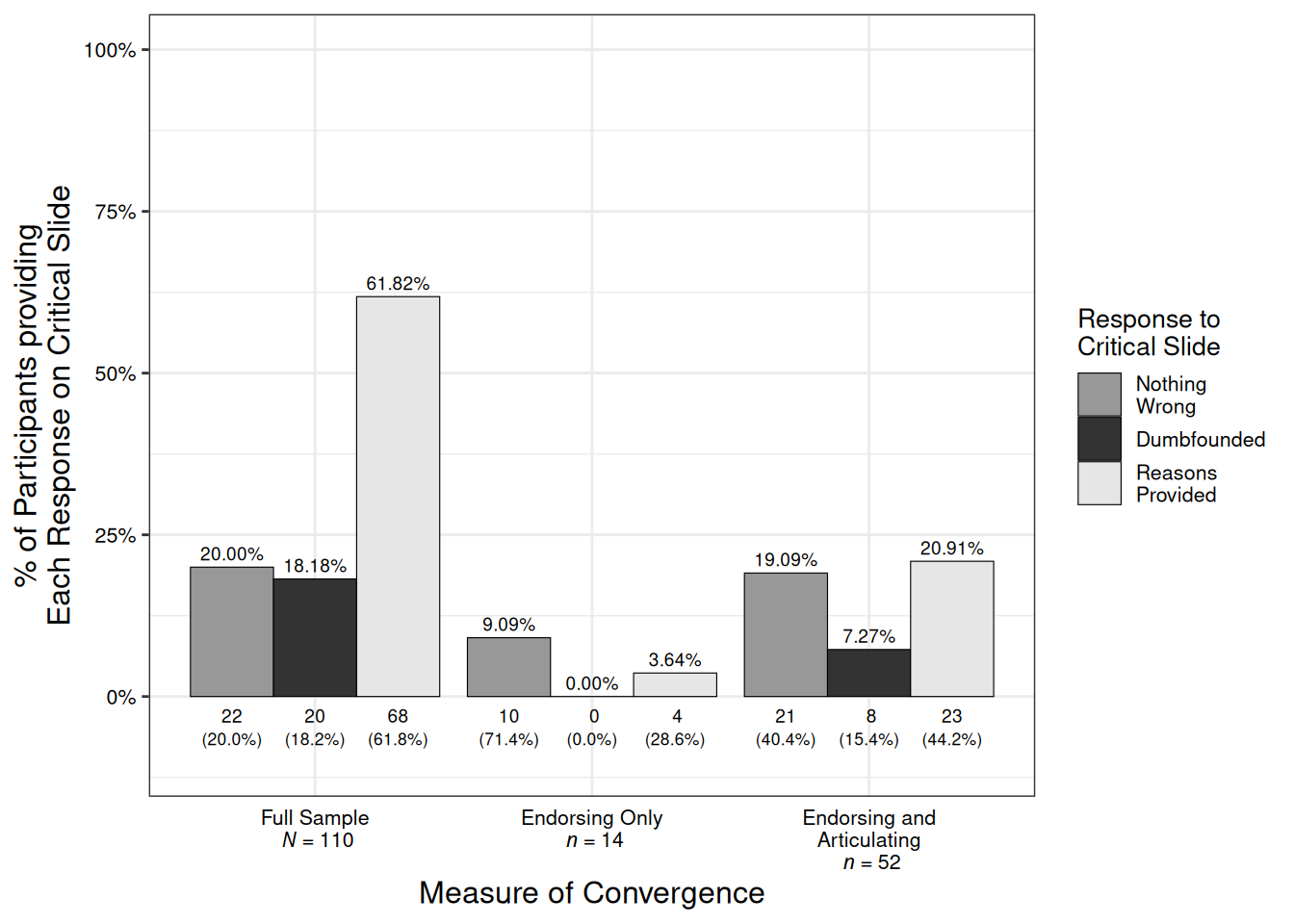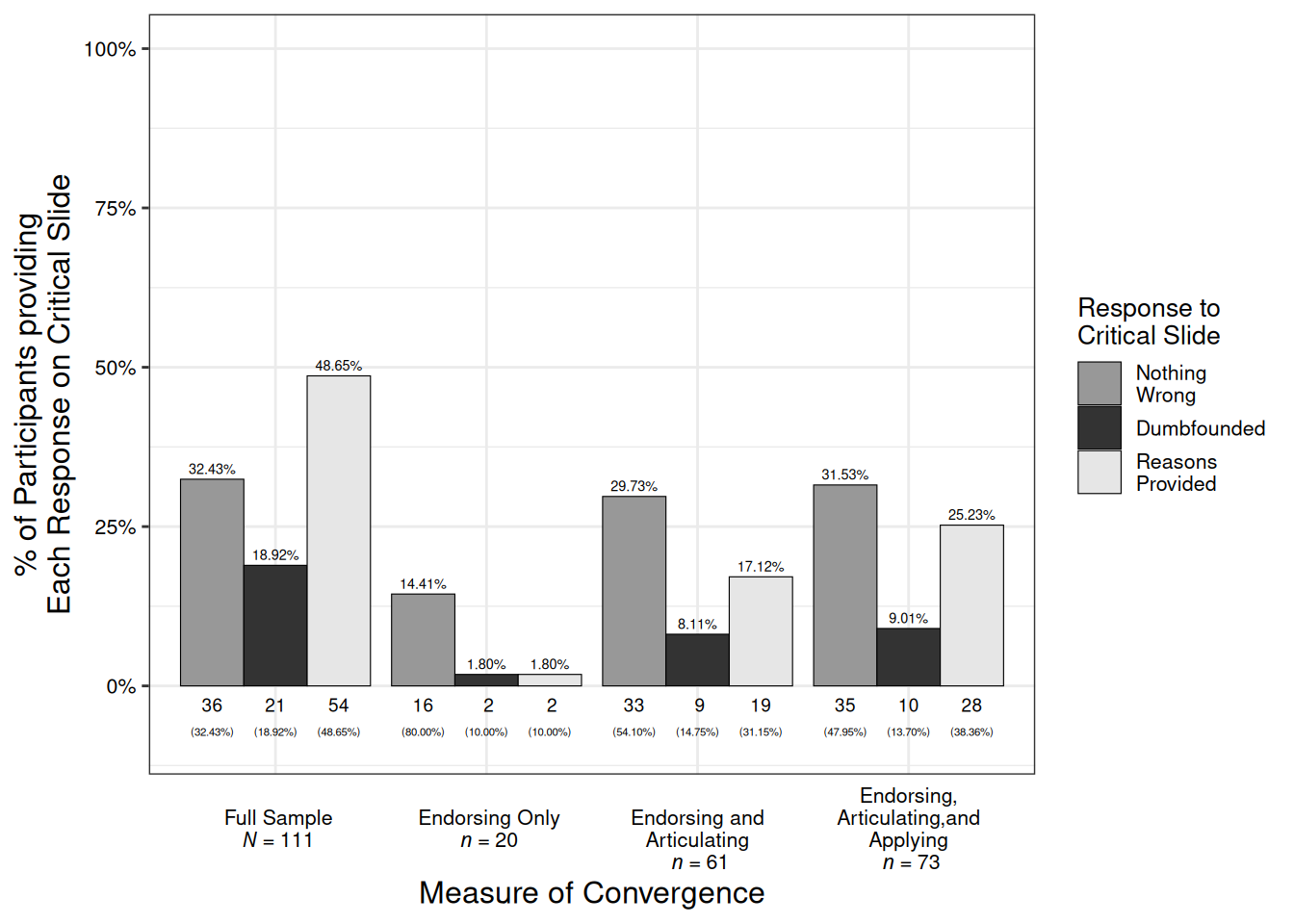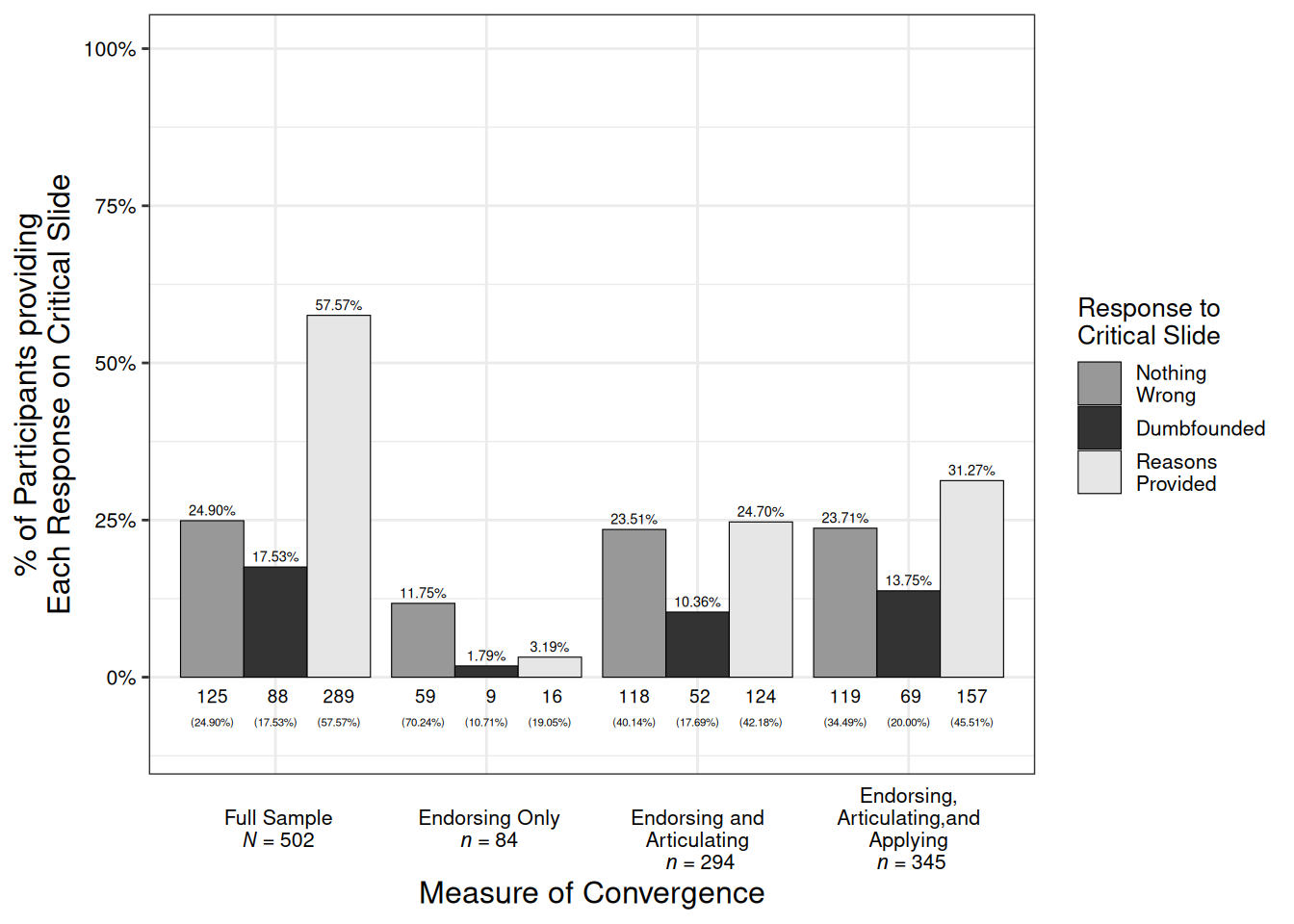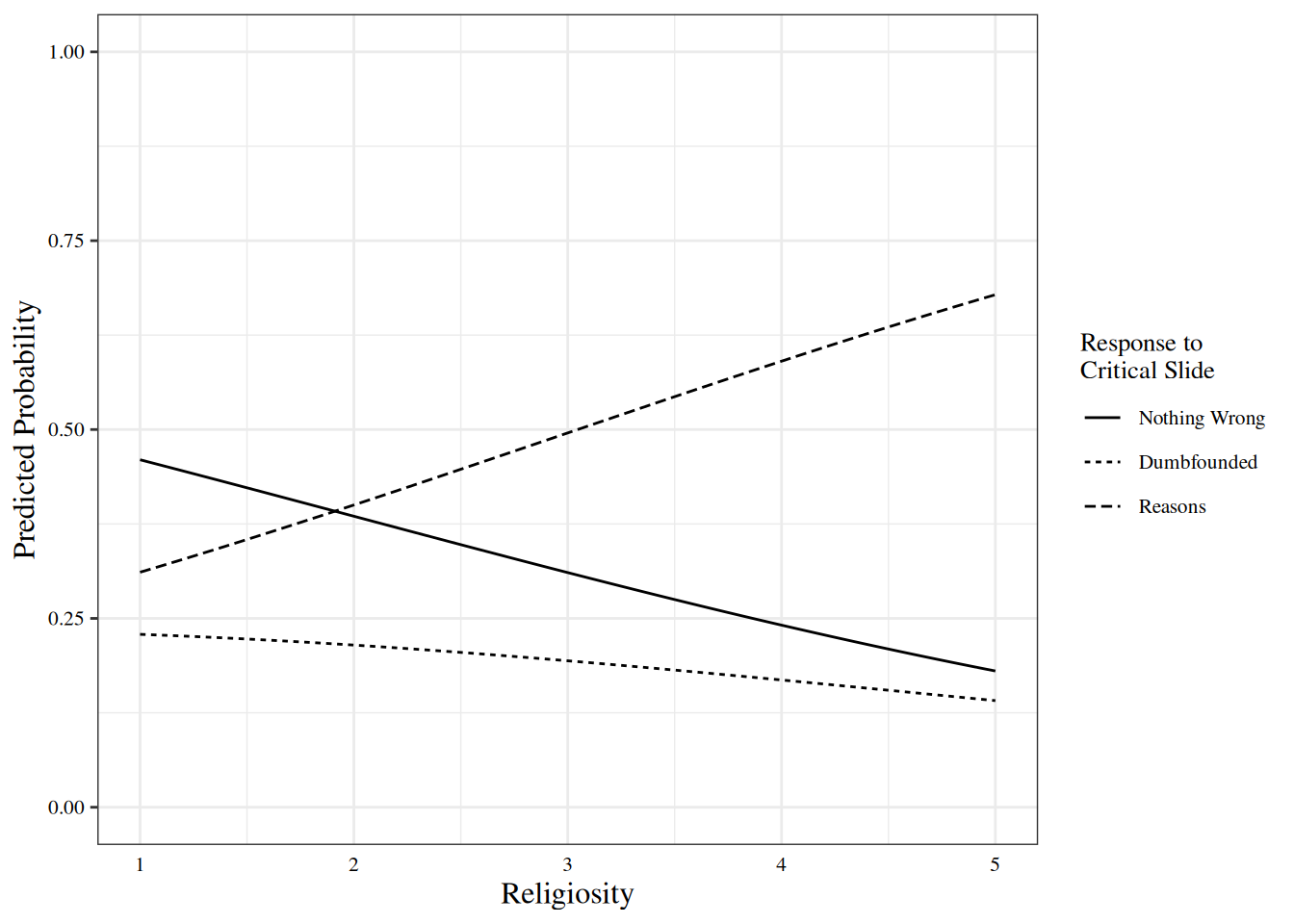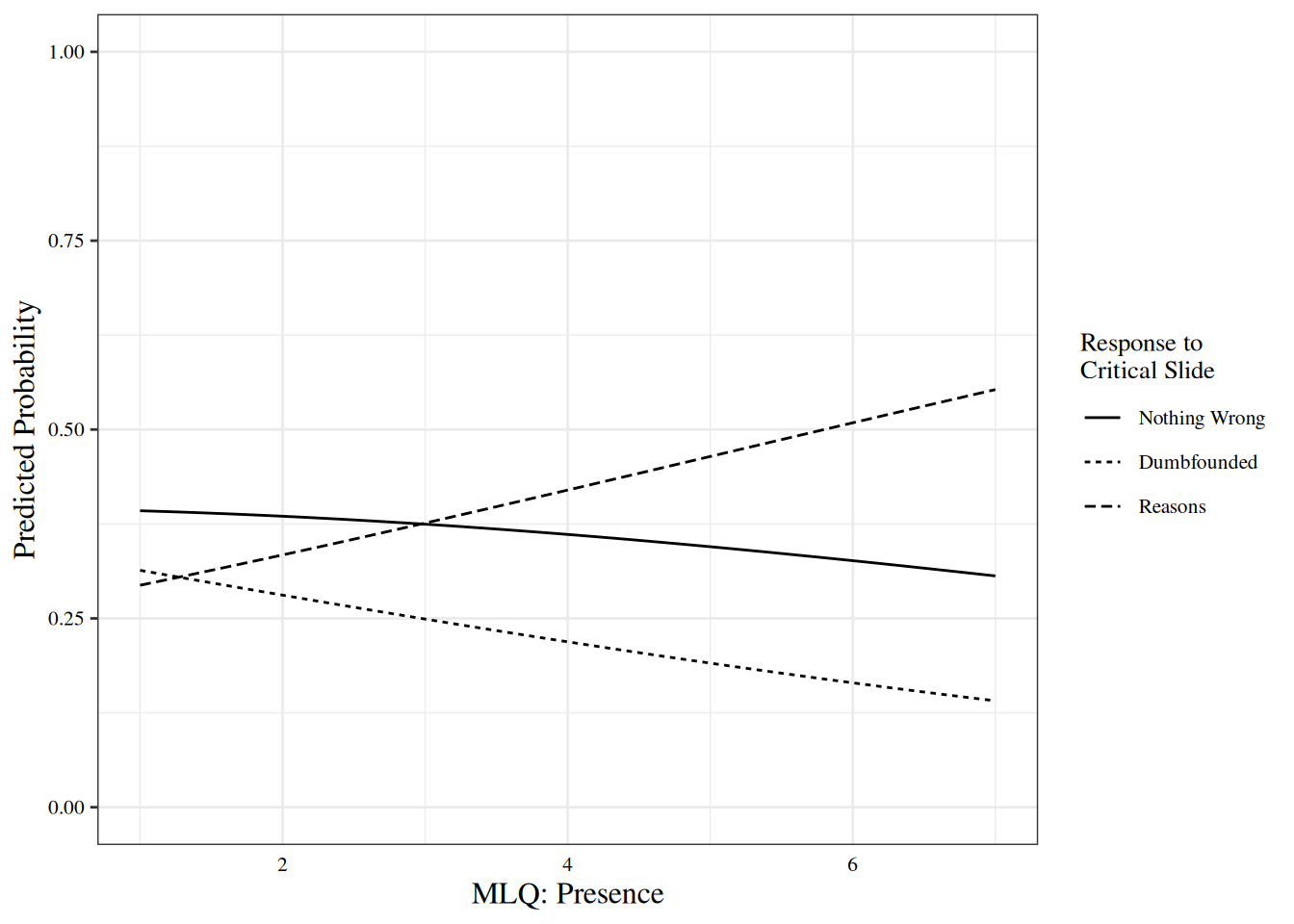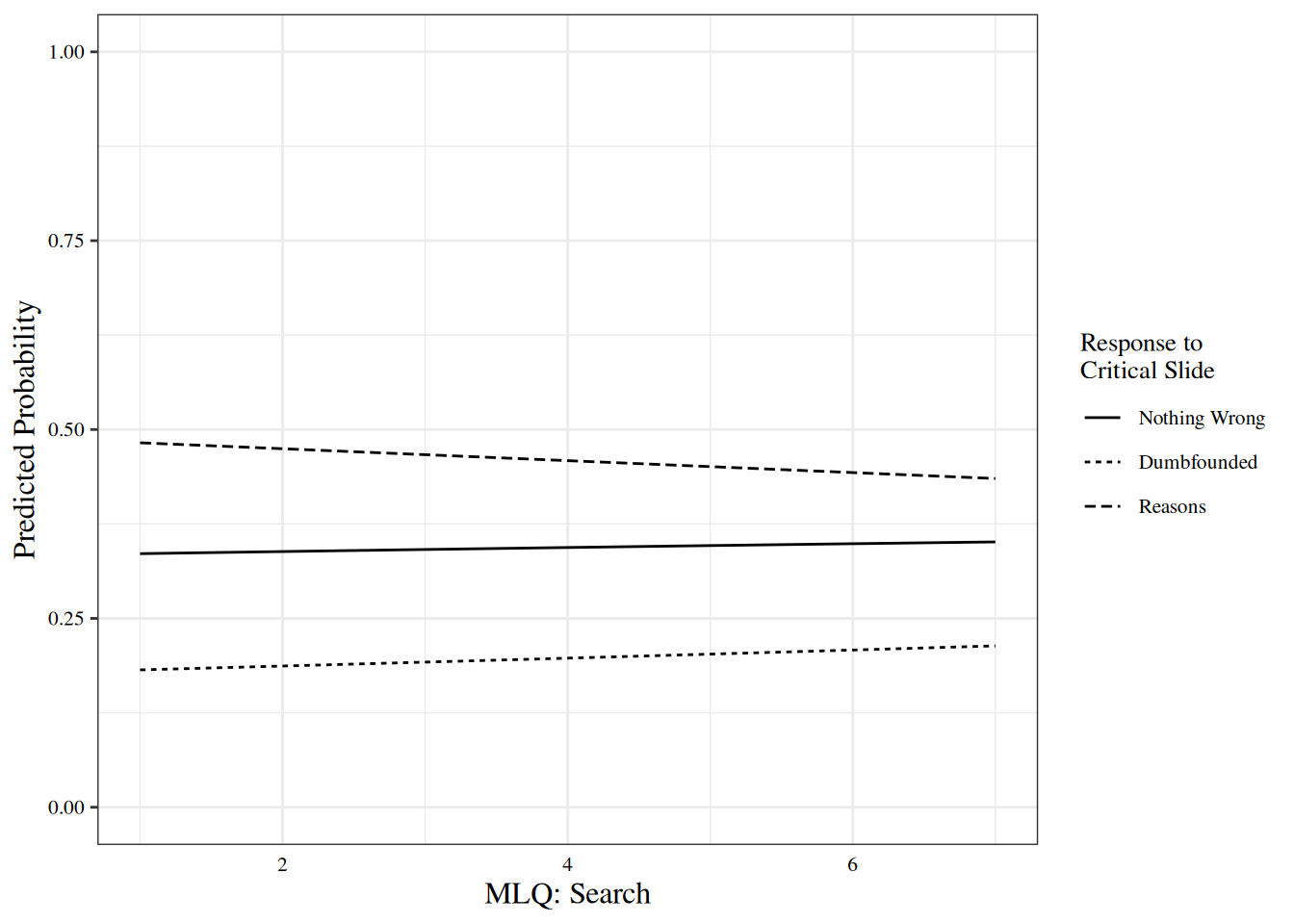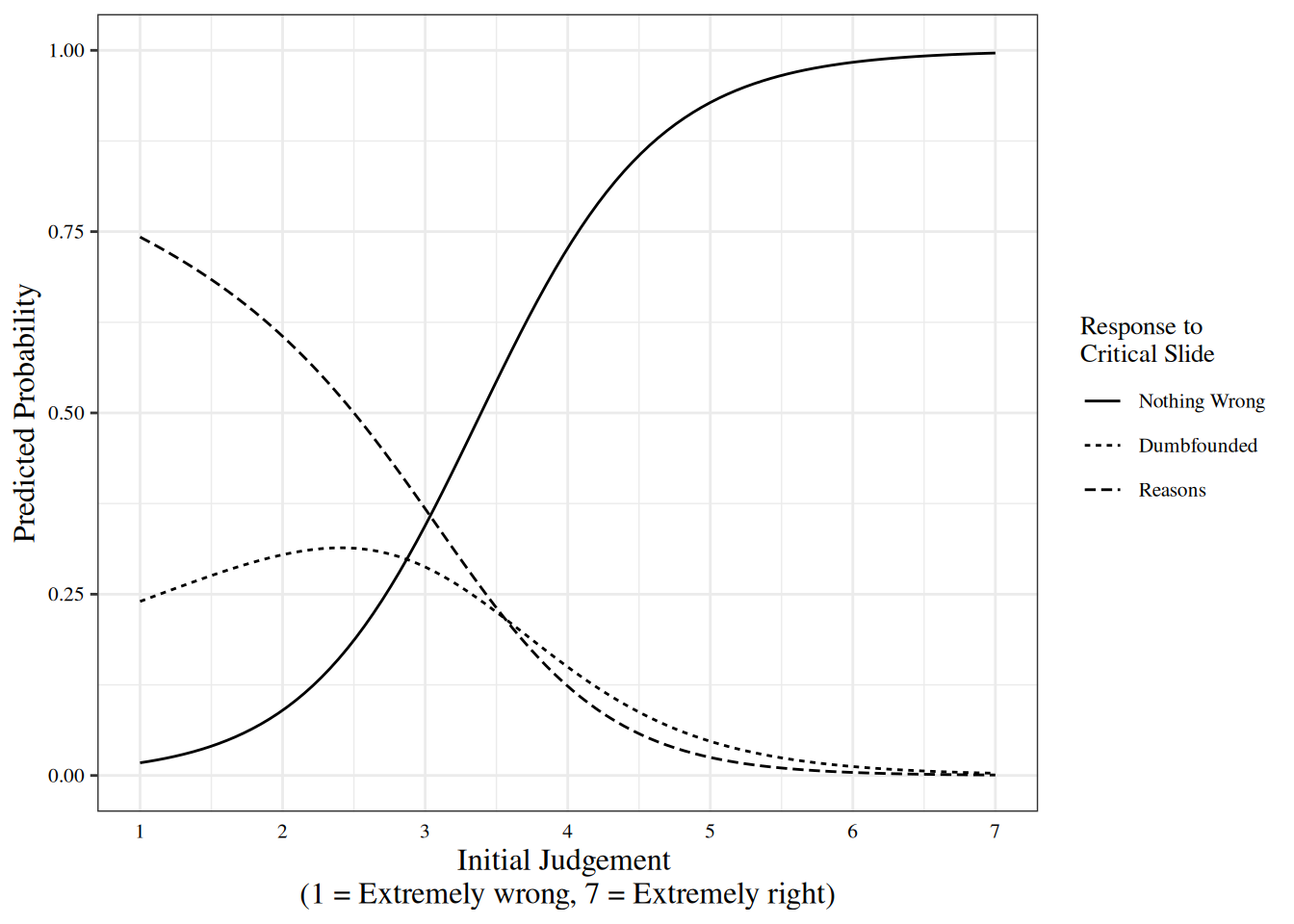Andri et mult. al., Signorell. 2021. DescTools: Tools for Descriptive Statistics. Manual.
Aust, Frederik. 2019. Citr: ’RStudio’ Add-in to Insert Markdown Citations. Manual.
Aust, Frederik, and Marius Barth. 2020. papaja: Create APA Manuscripts with R Markdown. Manual.
Bates, Douglas, Martin Mächler, Ben Bolker, and Steve Walker. 2015.
“Fitting Linear Mixed-Effects Models Using Lme4.” Journal of Statistical Software 67 (1): 1–48.
https://doi.org/10.18637/jss.v067.i01.
Bates, Douglas, and Martin Maechler. 2021. Matrix: Sparse and Dense Matrix Classes and Methods. Manual.
Bauman, Christopher W., A. Peter McGraw, Daniel M. Bartels, and Caleb Warren. 2014.
“Revisiting External Validity: Concerns about Trolley Problems and Other Sacrificial Dilemmas in Moral Psychology.” Social and Personality Psychology Compass 8 (9): 536–54.
https://doi.org/10.1111/spc3.12131.
Bonner, Carissa, and Ben R. Newell. 2010.
“In Conflict with Ourselves? An Investigation of Heuristic and Analytic Processes in Decision Making.” Memory & Cognition 38 (2): 186–96.
https://doi.org/10.3758/MC.38.2.186.
Bostyn, Dries H., Sybren Sevenhant, and Arne Roets. 2018.
“Of Mice, Men, and Trolleys: Hypothetical Judgment Versus Real-Life Behavior in Trolley-Style Moral Dilemmas.” Psychological Science 29 (7): 1084–93.
https://doi.org/10.1177/0956797617752640.
Brand, Cordula. 2016. Dual-Process Theories in Moral Psychology: Interdisciplinary Approaches to Theoretical, Empirical and Practical Considerations. Springer.
Cameron, C. Daryl, B. Keith Payne, and John M. Doris. 2013.
“Morality in High Definition: Emotion Differentiation Calibrates the Influence of Incidental Disgust on Moral Judgments.” Journal of Experimental Social Psychology 49 (4): 719–25.
https://doi.org/10.1016/j.jesp.2013.02.014.
Champely, Stephane. 2020. Pwr: Basic Functions for Power Analysis. Manual.
Christensen, Julia F., Albert Flexas, Margareta Calabrese, Nadine K. Gut, and Antoni Gomila. 2014.
“Moral Judgment Reloaded: A Moral Dilemma Validation Study.” Frontiers in Psychology 5: 1–18.
https://doi.org/10.3389/fpsyg.2014.00607.
Christensen, Julia F., and A. Gomila. 2012.
“Moral Dilemmas in Cognitive Neuroscience of Moral Decision-Making: A Principled Review.” Neuroscience & Biobehavioral Reviews 36 (4): 1249–64.
https://doi.org/10.1016/j.neubiorev.2012.02.008.
Crockett, Molly J. 2013.
“Models of Morality.” Trends in Cognitive Sciences 17 (8): 363–66.
https://doi.org/10.1016/j.tics.2013.06.005.
Croissant, Yves. 2020.
“Estimation of Random Utility Models in R: The mlogit Package.” Journal of Statistical Software 95 (11): 1–41.
https://doi.org/10.18637/jss.v095.i11.
———. 2021. Dfidx: Indexed Data Frames. Manual.
Cushman, Fiery A. 2013a. “The Role of Learning in Punishment, Prosociality, and Human Uniqueness.” In Signaling, Commitment and Emotion, Vol. 2: Psychological and Environmental Foundations of Cooperation, edited by Kim Sterelny, B Calcott, and B Fraser. MIT Press.
———. 2013b.
“Action, Outcome, and Value A Dual-System Framework for Morality.” Personality and Social Psychology Review 17 (3): 273–92.
https://doi.org/10.1177/1088868313495594.
Cushman, Fiery A., Liane Young, and Joshua David Greene. 2010. “Multi-System Moral Psychology.” In The Moral Psychology Handbook, edited by John M. Doris, 47–71. Oxford; New York: Oxford University Press.
Davison, A. C., and D. V. Hinkley. 1997. Bootstrap Methods and Their Applications. Cambridge: Cambridge University Press.
Dewey, Michael. 2021. metap: Meta-Analysis of Significance Values. Manual.
Dickinson, David L, and David Masclet. 2018. “Using Ethical Dilemmas to Predict Antisocial Choices with Real Payoff Consequences: An Experimental Study,” 28.
Evans, Jonathan St. B. T. 2003.
“In Two Minds: Dual-Process Accounts of Reasoning.” Trends in Cognitive Sciences 7 (10): 454–59.
https://doi.org/10.1016/j.tics.2003.08.012.
———. 2006.
“The Heuristic-Analytic Theory of Reasoning: Extension and Evaluation.” Psychonomic Bulletin & Review 13 (3): 378–95.
https://doi.org/10.3758/BF03193858.
———. 2008.
“Dual-Processing Accounts of Reasoning, Judgment, and Social Cognition.” Annual Review of Psychology 59 (1): 255–78.
https://doi.org/10.1146/annurev.psych.59.103006.093629.
Evans, Jonathan St. B. T., and David E. Over. 2013. Rationality and Reasoning. Psychology Press.
Fine, Cordelia. 2006.
“Is the Emotional Dog Wagging Its Rational Tail, or Chasing It?” Philosophical Explorations 9 (1): 83–98.
https://doi.org/10.1080/13869790500492680.
Flanagan, Owen, Hagop Sarkissian, and David Wong. 2008. “Naturalizing Ethics.” In Moral Psychology Volume 1: The Evolution of Morality Adaptations and Innateness, edited by Walter Sinnott-Armstrong, 1–26. Cambridge, Mass.; London, England: The MIT press.
Fletcher, Thomas D. 2012. QuantPsyc: Quantitative Psychology Tools.
Fox, John, and Sanford Weisberg. 2019. An R Companion to Applied Regression. Third. Thousand Oaks CA: Sage.
Fox, John, Sanford Weisberg, and Brad Price. 2020. carData: Companion to Applied Regression Data Sets. Manual.
Gray, Kurt James, Chelsea Schein, and Adrian F. Ward. 2014.
“The Myth of Harmless Wrongs in Moral Cognition: Automatic Dyadic Completion from Sin to Suffering.” Journal of Experimental Psychology: General 143 (4): 1600–1615.
https://doi.org/10.1037/a0036149.
Greene, Joshua David. 2008. “The Secret Joke of Kant’s Soul.” In Moral Psychology Volume 3: The Neurosciences of Morality: Emotion, Brain Disorders, and Development, 35–79. Cambridge (Mass.): the MIT press.
———. 2013. Moral Tribes: Emotion, Reason, and the Gap Between Us and Them. USA: The Penguin Press.
Greene, Joshua David, R B Sommerville, L E Nystrom, J M Darley, and J D Cohen. 2001.
“An fMRI Investigation of Emotional Engagement in Moral Judgment.” Science (New York, N.Y.) 293 (5537): 2105–8.
https://doi.org/10.1126/science.1062872.
Guglielmo, Steve. 2018.
“Unfounded Dumbfounding: How Harm and Purity Undermine Evidence for Moral Dumbfounding.” Cognition 170 (January): 334–37.
https://doi.org/10.1016/j.cognition.2017.08.002.
Haidt, Jonathan. 2001.
“The Emotional Dog and Its Rational Tail: A Social Intuitionist Approach to Moral Judgment.” Psychological Review 108 (4): 814–34.
https://doi.org/10.1037/0033-295X.108.4.814.
Haidt, Jonathan, and Fredrik Björklund. 2008. “Social Intuitionists Answer Six Questions about Moral Psychology.” In Moral Psychology Volume 2, The Cognitive Science of Morality: Intuition and Diversity, edited by Walter Sinnott-Armstrong, 181–217. London: MIT.
Haidt, Jonathan, Fredrik Björklund, and Scott Murphy. 2000. “Moral Dumbfounding: When Intuition Finds No Reason.” Unpublished Manuscript, University of Virginia.
Haidt, Jonathan, and Matthew A. Hersh. 2001.
“Sexual Morality: The Cultures and Emotions of Conservatives and Liberals.” Journal of Applied Social Psychology 31 (1): 191–221.
https://doi.org/10.1111/j.1559-1816.2001.tb02489.x.
Haidt, Jonathan, Silvia Helena Koller, and Maria G. Dias. 1993.
“Affect, Culture, and Morality, or Is It Wrong to Eat Your Dog?” Journal of Personality and Social Psychology 65 (4): 613–28.
https://doi.org/10.1037/0022-3514.65.4.613.
Hauser, Marc D., Liane Young, and Fiery A. Cushman. 2008. “Reviving Rawls’s Linguistic Analogy: Operative Principles and the Causal Structure of Moral Actions.” In Moral Psychology Volume 2, The Cognitive Science of Morality: Intuition and Diversity, edited by Walter Sinnott-Armstrong, 107–55. London: MIT.
Henry, Lionel, and Hadley Wickham. 2020. Purrr: Functional Programming Tools. Manual.
Huber, Stefan, and Odilo W. Huber. 2012.
“The Centrality of Religiosity Scale (CRS).” Religions 3 (3): 710–24.
https://doi.org/10.3390/rel3030710.
Jacobson, Daniel. 2012. “Moral Dumbfounding and Moral Stupefaction.” In Oxford Studies in Normative Ethics, 2:289.
Johnson-Laird, P. N. 2006. How We Reason. Oxford ; New York: Oxford University Press.
Kennett, Jeanette, and Cordelia Fine. 2009.
“Will the Real Moral Judgment Please Stand Up?” Ethical Theory and Moral Practice 12 (1): 77–96.
https://doi.org/10.1007/s10677-008-9136-4.
Kohlberg, Lawrence. 1969. Stages in the Development of Moral Thought and Action. New York: Holt, Rinehart & Winston.
———. 1971. From Is to Ought: How to Commit the Naturalistic Fallacy and Get Away with It in the Study of Moral Development.
MacNab, Scott. 2016. “MSPs to Consider ‘Abhorrent’ Call to Legalise Incest.” The Scotsman.
McHugh, Cillian. 2017. Desnum: Creates Some Useful Functions. Manual.
McHugh, Cillian, Marek McGann, Eric R. Igou, and Elaine L. Kinsella. 2017.
“Searching for Moral Dumbfounding: Identifying Measurable Indicators of Moral Dumbfounding.” Collabra: Psychology 3 (1): 1–24.
https://doi.org/10.1525/collabra.79.
Mercier, Hugo. 2016.
“The Argumentative Theory: Predictions and Empirical Evidence.” Trends in Cognitive Sciences 20 (9): 689–700.
https://doi.org/10.1016/j.tics.2016.07.001.
Mercier, Hugo, and Dan Sperber. 2011.
“Why Do Humans Reason? Arguments for an Argumentative Theory.” Behavioral and Brain Sciences 34 (2): 57–74.
https://doi.org/10.1017/S0140525X10000968.
———. 2017. The Enigma of Reason. Harvard University Press.
Müller, Kirill, and Hadley Wickham. 2021. Tibble: Simple Data Frames. Manual.
Mustonen, Anne-Mari, Tommi Paakkonen, Esko Ryökäs, and Petteri Nieminen. 2017.
“Abortion Debates in Finland and the Republic of Ireland: Textual Analysis of Experiential Thinking and Argumentation in Parliamentary and Layperson Discussions.” Reproductive Health 14 (1): 163.
https://doi.org/10.1186/s12978-017-0418-y.
Narvaez, Darcia. 2005. “The Neo-Kohlbergian Tradition and Beyond: Schemas, Expertise, and Character.” In Nebraska Symposium on Motivation, edited by Gustavo Carlo and C Pope-Edwards, 51:119. University of Nebraska Press.
Navarro, Danielle. 2015. Learning Statistics with R: A Tutorial for Psychology Students and Other Beginners. (Version 0.6). Manual. Sydney, Australia: University of New South Wales.
Nisbett, Richard E., and Timothy D. Wilson. 1977. “Telling More Than We Can Know: Verbal Reports on Mental Processes.” Psychological Review 84 (3): 231.
Plunkett, Dillon, and Joshua D. Greene. 2019.
“Overlooked Evidence and a Misunderstanding of What Trolley Dilemmas Do Best: Commentary on Bostyn, Sevenhant, and Roets (2018).” Psychological Science 30 (9): 1389–91.
https://doi.org/10.1177/0956797619827914.
Prinz, Jesse J. 2005. “Passionate Thoughts: The Emotional Embodiment of Moral Concepts.” In Grounding Cognition: The Role of Perception and Action in Memory, Language, and Thinking, edited by Diane Pecher and Rolf A. Zwaan, 93–114. Cambridge University Press.
Qiu, Weiliang. 2021. powerMediation: Power/Sample Size Calculation for Mediation Analysis. Manual.
R Core Team. 2017. “R: A Language and Environment for Statistical Computing.” Vienna, Austria: R Foundation for Statistical Computing.
———. 2020. Foreign: Read Data Stored by ’Minitab’, ’s’, ’SAS’, ’SPSS’, ’Stata’, ’Systat’, ’Weka’, ’dBase’, ... Manual.
Reber, Arthur S. 1989.
“Implicit Learning and Tacit Knowledge.” Journal of Experimental Psychology: General 118 (3): 219–35.
https://doi.org/10.1037/0096-3445.118.3.219.
Royzman, Edward B., Kwanwoo Kim, and Robert F. Leeman. 2015. “The Curious Tale of Julie and Mark: Unraveling the Moral Dumbfounding Effect.” Judgment and Decision Making 10 (4): 296–313.
Rozin, Paul, Jonathan Haidt, Clark MacCauley, D McKay, and Bunmi O. Olatunji. 2008. “Disgust: The Body and Soul Emotion in the 21st Century.” In Disgust and Its Disorders, 9–29. American Psychological Association.
Rozin, Paul, Laura Lowery, Sumio Imada, and Jonathan Haidt. 1999.
“The CAD Triad Hypothesis: A Mapping Between Three Moral Emotions (Contempt, Anger, Disgust) and Three Moral Codes (Community, Autonomy, Divinity).” Journal of Personality and Social Psychology 76 (4): 574–86.
https://doi.org/10.1037/0022-3514.76.4.574.
Sim, Philip. 2016. “MSPs Throw Out Incest Petition.” BBC News, January.
Singmann, Henrik, Ben Bolker, Jake Westfall, Frederik Aust, and Mattan S. Ben-Shachar. 2021. Afex: Analysis of Factorial Experiments. Manual.
Sneddon, Andrew. 2007.
“A Social Model of Moral Dumbfounding: Implications for Studying Moral Reasoning and Moral Judgment.” Philosophical Psychology 20 (6): 731–48.
https://doi.org/10.1080/09515080701694110.
Steger, Michael F., Todd B. Kashdan, Brandon A. Sullivan, and Danielle Lorentz. 2008.
“Understanding the Search for Meaning in Life: Personality, Cognitive Style, and the Dynamic Between Seeking and Experiencing Meaning.” Journal of Personality 76 (2): 199–228.
https://doi.org/10.1111/j.1467-6494.2007.00484.x.
Stepniak, Daniel. 1995. “Televising Court Proceedings Forum: Televising Court Proceedings.” University of New South Wales Law Journal, no. 2: 488–92.
Todd, Peter M., and Gerd Gigerenzer, eds. 2012. Ecological Rationality: Intelligence in the World. Evolution and Cognition Series. Oxford ; New York: Oxford University Press.
Topolski, Richard, J. Nicole Weaver, Zachary Martin, and Jason McCoy. 2013.
“Choosing Between the Emotional Dog and the Rational Pal: A Moral Dilemma with a Tail.” Anthrozoös 26 (2): 253–63.
https://doi.org/10.2752/175303713X13636846944321.
Triskiel, Janett. 2016. “Psychology Instead of Ethics? Why Psychological Research Is Important but Cannot Replace Ethics.” In Dual-Process Theories in Moral Psychology: Interdisciplinary Approaches to Theoretical, Empirical and Practical Considerations, edited by Cordula Brand, 77–98. Springer.
Unipark, QuestBack. 2013. “QuestBack Unipark.(2013).”
Venables, W. N., and B. D. Ripley. 2002. Modern Applied Statistics with S. Fourth. New York: Springer.
Wickham, Hadley. 2007. “Reshaping Data with the reshape Package.” Journal of Statistical Software 21 (12): 1–20.
———. 2011. “The Split-Apply-Combine Strategy for Data Analysis.” Journal of Statistical Software 40 (1): 1–29.
———. 2016. Ggplot2: Elegant Graphics for Data Analysis. Springer-Verlag New York.
Wickham, Hadley, Romain François, Lionel Henry, and Kirill Müller. 2020. Dplyr: A Grammar of Data Manipulation. Manual.
Wickham, Hadley, and Dana Seidel. 2020. Scales: Scale Functions for Visualization. Manual.
Wielenberg, Erik J. 2014. Robust Ethics: The Metaphysics and Epistemology of Godless Normative Realism. Oxford, United Kingdom: OUP Oxford.
Yee, Thomas W. 2010. “The VGAM Package for Categorical Data Analysis.” Journal of Statistical Software 32 (10): 1–34.
———. 2013. “Two-Parameter Reduced-Rank Vector Generalized Linear Models.” Computational Statistics and Data Analysis.
———. 2020. “The VGAM Package for Negative Binomial Regression.” Australian and New Zealand Journal of Statistics 61.
Yee, Thomas W., and Alfian F. Hadi. 2014. “Row-Column Interaction Models, with an R Implementation.” Computational Statistics 29 (6): 1427–45.
Yee, Thomas W., Jakub Stoklosa, and Richard M. Huggins. 2015. “The VGAM Package for Capture-Recapture Data Using the Conditional Likelihood.” Journal of Statistical Software 65 (5): 1–33.
Yee, Thomas W., and C. J. Wild. 1996. “Vector Generalized Additive Models.” Journal of Royal Statistical Society, Series B 58 (3): 481–93.
